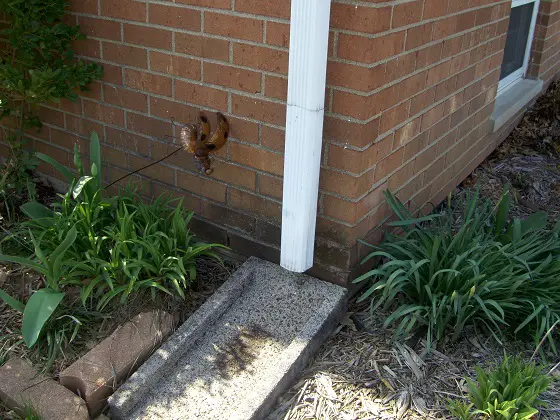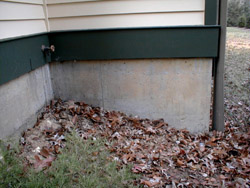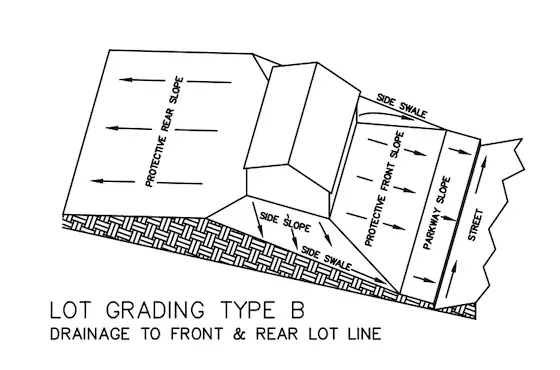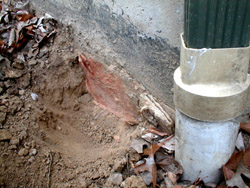Positive Drainage Keeps a House Dry

Splash blocks don't do much to channel water away from the foundation.
Positive Drainage Keeps a House Dry
DEAR TIM: I am building a new home soon and I do not want water drainage problems of any sort in my yard. My existing home is built on a slab and I frequently have standing water around the house after a rainfall. My new home will have a basement. Can I build a house with a dry basement or will it leak over time and become damp, musty, and useless? Surely there must be a way to eliminate all water problems around a home. Amy C., Dubuque, IA
DEAR AMY: You bet it is possible to eliminate water problems around the average home. The good news is that many of the things required to achieve a dry, well-drained lot are very economical. The largest expense will be the cost to actually waterproof your new foundation. It is a one-time expense and if you use one of the better systems out there your basement, like mine, will be bone dry for many years to come.

The earth is sloped correctly. Water runs away from the house foundation.
The first thing your builder needs to do is to make sure that the top of your foundation or slab actually sticks high enough out of the ground. All too often builders set houses into the ground too deeply. When this happens it is nearly impossible for a builder to create gentle sloping grades that direct water away from the house and to the lowest point of the lot where water would have drained naturally before the house was built.
The model building codes are very specific about foundation drainage and many state that the ground should slope at least six inches down in the first ten feet of distance away from the house. If your house is built close to the lot line a ditch needs to be built that allows similar natural drainage.

Note how the ground slopes away from the house on all sides.
Water that leaves your roof can cause all sorts of problems if it is not collected and piped away from the house. An average one-floor house might have approximately 2,400 square feet of surface area on the roof. When a storm produces one inch of rain, the amount of water draining from the roof to the ground equals nearly 1,500 gallons! Allowing this water to simply collect near the house or discharge from downspouts onto simple splash blocks at the base of a foundation is asking for trouble.
The better solution is to pipe this water away from the house. Many municipalities are now requiring that this stormwater be collected and put into retention ponds before being allowed to enter natural drainage systems like brooks and streams. Interior sump pump discharge pipes should also be connected to these downspout drain pipes. Allowing sump water to discharge alongside a foundation is insanity. The water you just paid to pump will usually enter the sump again in a matter of hours.

You can see the black rubberized asphalt that waterproofs the foundation. The pink is rigid fiberglass that protects the waterproofing material.
Make sure your builder waterproofs your foundation. Do not confuse true waterproofing systems with the thin sprayed-on asphalt that many builders install. The thin asphalt coatings are dampproofing and meet the minimum code requirements for unfinished basement areas. My basement is actually waterproofed. I used a thick modified asphalt compound that actually contains rubber. The rubber allows the material to bridge small cracks that may develop at a later date. The thick coating was then covered by rigid fiberglass insulation that keeps my basement walls warm and helps to channel water directly to the drain tile at the base of my foundation.
There are other high-quality waterproofing systems out there. Some are actually synthetic rubbers that have incredible elastic properties. Other systems use a natural clay that swells when it gets wet. You can even get special urethanes that will waterproof a foundation. Finally, there are some innovative plastic foundation wraps that claim to waterproof a foundation. These plastic products come in large rolls and look like a muffin pan. The bumps in the plastic create a pathway for water to easily flow down the sides of the foundation to the drain tile.
The key to a dry basement and lot is to cooperate with Mother Nature. One of her rules happens to be gravity. Use it to your advantage. Make sure that you use gravity to pipe surface and sub-surface water away from your house as quickly as possible. Do this and you will be the driest person on your block.
This popular column was the Magic Secret Link in the July 3, 2015 AsktheBuilder Newsletter.
Column 339